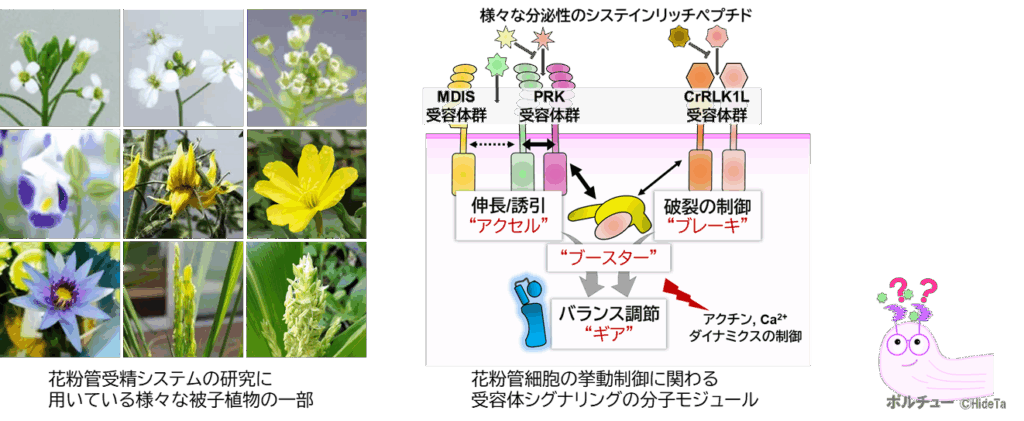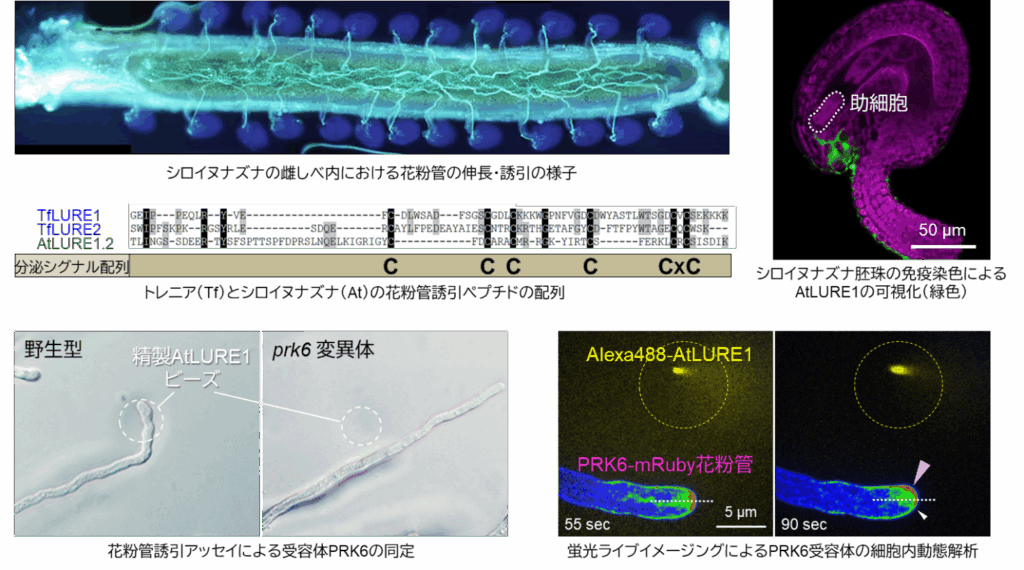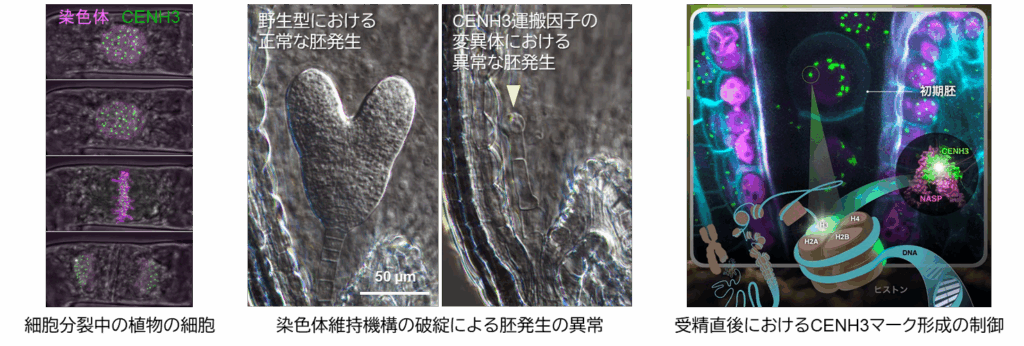Research
In our laboratory, we focus on the precise yet flexible, multi-step communication between male and female components in angiosperms—flowering plants that reproduce sexually. We aim to uncover the molecular mechanisms that regulate these processes.
Our research covers a wide range of phenomena, from pre-fertilization events that enable male and female cells to meet, to the post-fertilization processes that follow. Centered around the research topics introduced below, we investigate the underlying systems governing each stage of reproduction.
By striving to understand these principles deeply enough to manipulate them at will, we seek to experimentally approach the fundamental question: “What defines a species?” At the same time, we aim to develop innovative technologies for plant breeding.。
1. Research on the Driving Mechanisms and Evolution of the Pollen Tube Fertilization System
Angiosperms have evolved a reproductive strategy that enables fertilization to occur deep within the ovule, located inside the pistil, in order to ensure successful reproduction in dry terrestrial environments. A key component of this reproductive system is the male gametophyte cell known as the pollen tube.
The pollen tube is a tubular, single cell that undergoes tip growth—a form of polarized, unidirectional cell elongation—to directly deliver sperm cells to the egg cell. This mode of fertilization is known as siphonogamy (pollen tube-mediated fertilization), and angiosperms have developed highly innovative mechanisms to regulate the pollen tube’s behavior.
Specifically, angiosperms have acquired a sophisticated system in which a single pollen tube cell precisely executes multiple complex behaviors: elongation through the pistil, guidance toward the synergid cells of the ovule, and rupture to release the enclosed sperm cells. These coordinated actions are critical for achieving efficient fertilization.

Recent studies, including our own work(Takeuchi & Higashiyama, 2012, PLoS Biology; Takeuchi & Higashiyama, 2016, Nature; Zhang, Liu, Nagae et al., 2017, Nature Communications; Takeuchi, 2021, Peptides)have progressively revealed that secreted peptide–receptor signaling plays a central role in regulating pollen tube behavior.

However, it remains unclear how each of these signaling pathways regulates specific pollen tube behaviors, and how multiple signaling pathways are integrated and fine-tuned. Moreover, within the pistil—the actual stage for male–female communication—it is still unknown by what principles and dynamics the pollen tube is remotely controlled.
Our goal is to unravel these fundamental questions and to gain a comprehensive understanding of the mechanisms and evolution of the pollen tube fertilization system, which is utilized by all angiosperms—over 300,000 species—on Earth.
2. Research on “Chromosome Maintenance” Focused on the Fertilization Process in Plants
When sperm cells are delivered to the egg cell via the pollen tube, they fuse to form a zygote. Through subsequent cell divisions of the zygote and early embryo, the paired sets of chromosomes—one from the male and one from the female—are faithfully maintained. This ensures that while the parental genomes are mixed, the resulting individual retains the species’ genetic identity.
In plants, where changes at the chromosomal level are more readily tolerated than in animals, the maintenance of chromosomes also plays a crucial role in species evolution. However, the molecular mechanisms underlying chromosome maintenance in plants remain largely unknown, and the plant-specific processes that occur during fertilization are still poorly understood.
We focus on the centromere-specific histone H3 variant (CENH3), a key molecule in chromosome maintenance. By combining genetic analysis with imaging of zygotes and early embryos, we aim to understand how CENH3 marks are established—and, ultimately, to elucidate the mechanisms of chromosome maintenance (Takeuchi et al., 2024, Plant & Cell Physiology).
In particular, by applying perspectives and techniques from plant reproductive biology, we strive to identify novel key molecules involved in chromosome maintenance and to uncover the dynamics and regulatory networks that govern this process. Furthermore, based on a deep understanding of these principles, we aim to develop chromosome manipulation technologies that will lead to innovative approaches in plant breeding.

3. Research and Development Aimed at Creating Novel Plant Breeding Technologies
Genome Editing and Chromosome Manipulation
To flexibly and rapidly modify plant traits, genome editing technologies—particularly CRISPR/Cas systems—are indispensable. Even in fundamental research using Arabidopsis thaliana to explore basic biological principles, genome editing plays a central role. We are actively developing efficient vector systems and establishing practical pipelines for genome editing applications (Takeuchi & Nagahara, 2024, bioRxiv).
Furthermore, we are working to introduce gene knock-in techniques, which are still uncommon in plants, by leveraging CRISPR-based approaches. Through these advancements, we aim to move beyond simple gene editing toward true genome editing and, ultimately, toward technologies for chromosome-level manipulation.
A Novel Method for Plant Trait Modification Using Pollen Tubes Pollen tubes function as “carriers of genetic information” and are a feature shared by all angiosperms. Focusing on this universal capability, we are exploring the development of innovative transformation methods that utilize pollen tubes, particularly for plant species that are not amenable to conventional genetic transformation techniques.
Furthermore, by integrating chemical approaches, we ultimately aim to achieve genome and chromosome editing without relying on genetic modification, opening the door to entirely new strategies for plant trait manipulation.
Interspecies Hybridization The sexual reproduction systems we study are typically designed to ensure reproduction occurs only between individuals of the same species. Conversely, if these systems can be understood and manipulated at the molecular level, it may become possible to enable controlled interspecies hybridization.
By overcoming pre-fertilization hybridization barriers and combining this with chromosome manipulation techniques, we envision the development of methods to create entirely new and beneficial plant varieties that have never existed before.
With the aim of establishing innovative plant breeding strategies, we are steadily advancing research and development to uncover the underlying principles and demonstrate practical applications.

Laboratory Vision and Key Characteristics
Our research is fundamentally anchored in an experimental approach using the model dicot Arabidopsis thaliana. In addition, we actively utilize data from diverse plant species and their genomes and genes, always keeping the evolution of molecular systems in mind as we conduct our analyses.
A typical research strategy involves identifying key molecules through molecular genetics and molecular evolution, and then elucidating the regulatory mechanisms behind reproductive phenomena using molecular and cellular biology as well as plant physiology. Multiscale imaging—such as live imaging and high-resolution microscopy—is also a vital part of our toolkit. Moreover, constructing experimental materials through rigorous molecular genetic techniques is essential, and we are steadily advancing pipeline development and technical innovations to support this.
That said, we do not believe research should be limited by specific materials or methodologies. What we value most is logical thinking based on solid experimental data, along with intrinsic creativity that transcends conventional logic. Even the development of technical tools to pursue an idea can become a significant research topic in itself, especially when considering broader impacts.
While we are deeply committed to exploring fundamental principles, we also pursue foundational research that supports practical applications. To this end, we actively engage in interdisciplinary collaborations that bridge basic science and real-world innovation.










